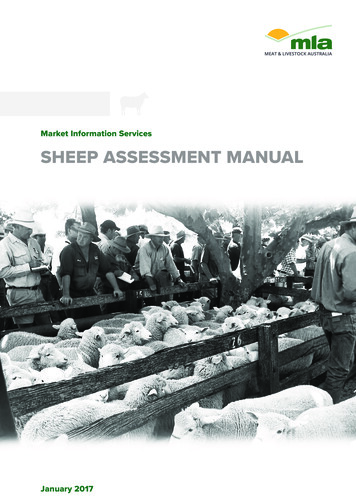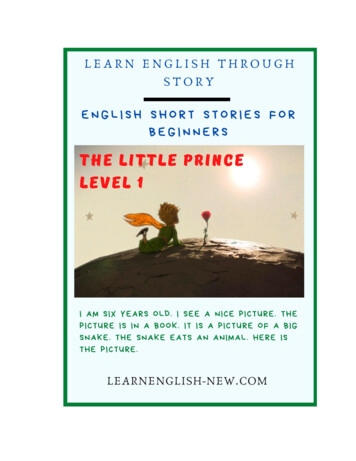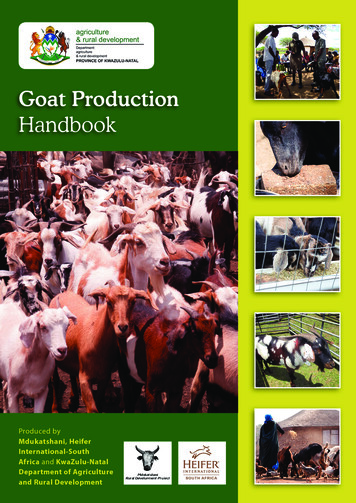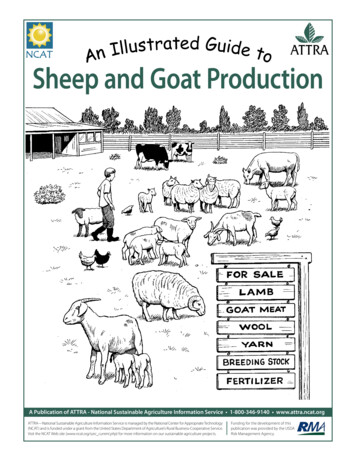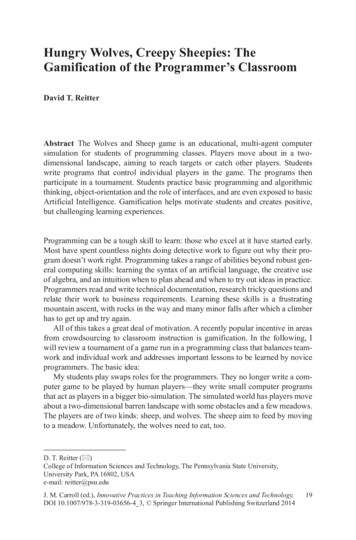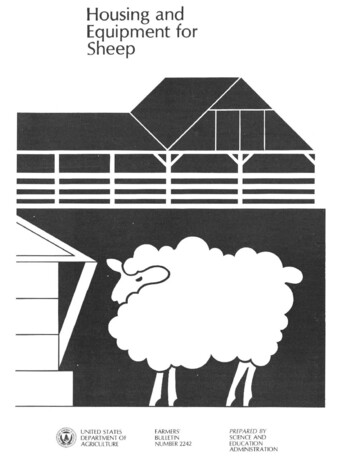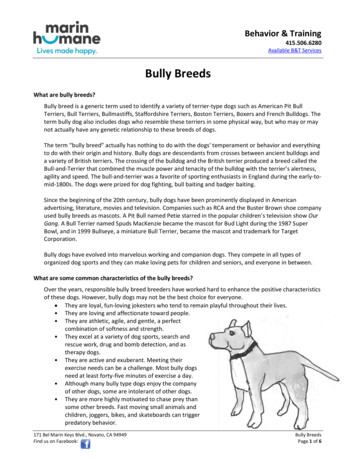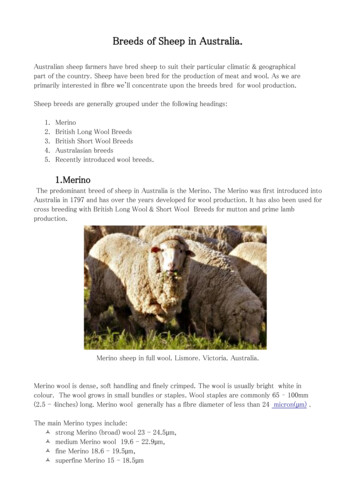
Transcription
Breeds of Sheep in Australia.Australian sheep farmers have bred sheep to suit their particular climatic & geographicalpart of the country. Sheep have been bred for the production of meat and wool. As we areprimarily interested in fibre we'll concentrate upon the breeds bred for wool production.Sheep breeds are generally grouped under the following headings:1.2.3.4.5.MerinoBritish Long Wool BreedsBritish Short Wool BreedsAustralasian breedsRecently introduced wool breeds.1.MerinoThe predominant breed of sheep in Australia is the Merino. The Merino was first introduced intoAustralia in 1797 and has over the years developed for wool production. It has also been used forcross breeding with British Long Wool & Short Wool Breeds for mutton and prime lambproduction.Merino sheep in full wool. Lismore. Victoria. Australia.Merino wool is dense, soft handling and finely crimped. The wool is usually bright white incolour. The wool grows in small bundles or staples. Wool staples are commonly 65 – 100mm(2.5 - 4inches) long. Merino wool generally has a fibre diameter of less than 24 micron(µm) .The main Merino types include: strong Merino (broad) wool 23 - 24.5µm, medium Merino wool 19.6 - 22.9µm, fine Merino 18.6 - 19.5µm, superfine Merino 15 - 18.5µm
and ultra fine merino 11.5 – 15µm.Ultra fine Merino wool is suitable for blending with other fibres such as silk and cashmere.Special Characteristics of Merino wool*Having a very high comfort factor Super fine and Ultra fine Merino wool is used inworsted cloth for suiting material .high end*Merino wool is also common in high-end, performance athletic wear.*Merino wool is the softest types of wool available, due to its finer fibres and smallerscales.*Merino Wool has fine crimp along the entire fibre length and a natural bright whitecolour.*The raw fleece has a high grease content. The grease or lanolin has antibacterialproperties.*Merino wool has good elasticity and excellent loft.*Fine Merino wool can be difficult for beginning handspinners to spin because of itssoftness and shorter fibres*Good felting wool*Merino wool is best if spun fine*Merino can be spun using woollen or worsted methods*Fine wools spin well into fine yarns for knitting and crochet projects.*The softness of fine Merino wools makes them ideal for creating garments that can beworn against the skin. They are especially ideal for making baby clothes.*Fine wools blend well, and add elasticity and loft to other exotic fibres, such as,cashmere,alpaca, angora, camel, silk, and mohair.
2. British Long Wool BreedsThe British Long Wool breeds were originally brought to Australia for experimental purposes.These sheep are suited to high rainfall areas.a). LincolnThe Lincoln has a large frame and is a hornless sheep. It has long lustrous wool with a staplelength of 200 – 300 mm. Its wool is very coarse, 34 – 41 microns with medullated (hollow) fibres.Lincoln sheep.b). English LeicesterThe English Leicester has a large frame and is a hornless sheep with black feet. The EnglishLeicester has lustrous wool with a staple length of 200 – 250 mm. The wool has a fibre diameterfrom 32 – 35 microns.English Leicester sheep.c). Border LeicesterThe Border Leicester is a large framed hornless sheep. It has lustrous wool of 175 – 225 mmstaple length and a fibre diameter of 32 – 34 micron. The Border Leicester is a popular breed forproducing first cross ( Merino ewe x Border Leicester ram ) ewes. The first cross ewes areprolific at producing twins are good milkers and their lambs mature quickly for the meat market.Border Leicester sheep.
d). CheviotThe Cheviot is a large-framed sheep with a white hornless head that is free from wool. TheCheviot produces soft handling, chalky coloured wool with a staple length of 100 – 150 mmand a fibre diameter of 27 -33 microns. The Cheviot produces prime lamb sires.Cheviot sheepe). Romney MarshThe Romney Marsh is a large-framed, hornless sheep. It has a thick top knot a white face andkemp fibres on its face and legs. The Romney Marsh produces demi- lustrous wool of 75 – 200mm staple length and 30 – 34 microns fibre diameter. Romney marsh ewes are excellent motherand when crossed with British Short wool breeds, produce high quality lamb.Romney Marsh Ram.
3. British Short Wool (Downs) BreedsThe British Short Wool Breeds are commonly known as Downs breeds. They grow wool which iscomparatively harsh to handle, chalky (flat lustre) in appearance , has a staple length in the 50– 130 mm range and a fibre diameter between 23 – 27 micron.The downs breeds have fine grain meat and are commonly used as prime lamb sires.a). SouthdownThe Southdown has a small chunky frame and a wide back. Its head is well covered with wooland it is polled (no horns). Its wool is harsh to handle and has a short staple length, generally 50– 75mm and a fibre diameter in the 24 – 29 micron range.Southdown Ramb). Dorset Horn and Poll DorsetThe Dorset Horn has a medium sized blocky frame, a wide long back and wool that grows downthe face to the top of the muzzle. It has heavy curled horns (the poll Dorset is without horns).The wool is chalky white in appearance and relatively harsh to handle. The wool staple lengthgenerally grows to 75 – 125 mm and the wool fibre diameter is in the 26 – 32 micron range.Poll Dorsets and Dorset Horns are renowned as prime lamb sires and are usually mated tocrossbred (Merino cross), British Long Wool or Merino ewes.Poll Dorset ewes
c). SuffolkThe Suffolk has a medium blocky frame, wide back and black head, black legs and black hooves.It is hornless. Its wool is 75 – 100 mm in staple length and a fibre diameter in the 26 -33 micronrange. The Suffolk is renowned for its hardiness, the exceptionally quick growth of lambs andhigh meat dressing percentage.The White Suffolk is an Australian breed developed for Australian conditions. The White Suffolkwas developed from breeding programs involving the Suffolk breed, which was initially crossedwith white wool breeds (mainly the Poll Dorset). Its head is white and free of wool and hornlessand its legs are white. It is predominantly a high performance meet sheep breed.Suffolk RamWhite Suffolk Ram (Ida Vale Stud W.A)d). TexelThe Texel is a well-developed, evenly proportioned heavily muscled, lean sheep. It is polled witha clean white face and black nostrils. The wool is generally dense, 100mm in staple length and inthe 30 – 36 micron range. The Texel is predominantly a meat breed.Texel ewe.
4. Australasian BreedsThe Australasian breeds include the Coopworth, Corriedale, Polworth, Perendale, Poll Dorset,Gromark, Cormo and South Suffolk. The Corriedale and Polworth have been developed as dualpurpose sheep and have good wool producing and meat characteristics as well as goodreproductive performance.a). CorriedaleThe Corriedale is a dual purpose sheep. The breed was developed by mating purebred Merinoewes with English Long Wool Lincoln rams. The subsequent half bred progeny were then inbredfor seven generations to maintain the new 'pure' breed.The Corriedale has a large framed body which is practically free of skin wrinkle. It has a polledhead, dark hooves and wooled legs. The wool is 100 – 150 mm in staple length and has a fibrediameter in the 25 – 32 micron range.Corriedale wool is ideal for beginning hand spinners as it has a good staple length and will spininto a medium to thick yarn. The wool is moderately soft. Corriedale wool is also good for feltingprojects.Corriedale
b). PolwarthThe Polwarth is a dual-purpose sheep bred from a Lincoln-Merino Cross. The Polworth isThree-quarter Merino and one quarter Lincoln, and closely resembles the Corriedale in generalappearance. The Polwarth has a large framed body, usually with some neck folds, polled, has nokemp on the face and legs and is well woolled. The wool is 100 – 130 mm staple length with afibre diameter of 23 -25 microns (visual count : 64s, 60s, 58s).The Polwarth is well suited to wetter, colder areas where medium and strong woll Merinos fail tothrive. The Polwarth is a dual purpose breed with almost equal emphasis on meat and woolproduction. The ewes are good mothers.Polwarthc). CoopworthThe Coopworth is the result of combining Border Leicester and Romney Marsh bloodlines. It wasdeveloped in New Zealand. The Coopworth has clean legs, is polled and has excellent motheringand milking ability. It produces a white lustrous wool of 150-200mm staple length and 30-35microns (visual quality count: 40-46s).Coopworth
The table below summarises the Australian breeds and their fleece characteristics.BreedFleece CharacteristicsBreed CharacteristicsCorriedaleStaple length: 100-150mmMicron: 25-32 um(Visual quality count: 50-58s)White legs, ears, face, blackhooves, hornless, broad head withwide black nostrils.PolwarthStaple length: 100-130mmMicron: 23-25 um(Visual quality count: 64s-58s)Merino/Lincoln crossed withMerino. Soft white face, blackmottles on nose, white legs, nokemp on face or legs.CoopworthStaple length: 150-200mmMicron: 30-35 um(Visual quality count: 40-46s)Border Leicester/Romney cross.White open face, clean legs,polled.CormoStaple length: 90-130mmMicron: 18-23 um(Visual quality count: 74-60s)Developed from superfine SaxonMerino/ Corriedale cross. Fastgrowing, medium frame, open face,polled.PerendaleStaple length: 100-125mmMicron: 28-32 um(Visual quality count: 50-56s)Cheviot/Romney. White open face,dark nostrils and feet, white legs,polled.GromarkStaple length: 150-250mmMicron: 27-33 um(Visual quality count: 50s)Corriedale/Border Leicester.White open face, clean legs, polledSouth SuffolkStaple length: 75-10mmMicron: 24-26 um(Visual quality count: 58-60s)Brown to black open face, brownto black legs, black hooves.
5. Recently Introduced Wool Breeds.Finn Sheep.A recent import from Finland and Denmark. Finn sheep are a fast growing, lean sheep breed.Multiple birthing of triplets and quads is common.The Finn is a white fat tailed breed. The head is polled, the face free from wool and it shouldhave white feet. The wool is even, soft and lustrous. It is a white wool with good even staplelength and lock. The crimp is well defined and even from staple base to tip. Micron range 20 26um.Finn ewe with quadruplets.
cashmere, alpaca, angora, camel, silk, and mohair. 2. British Long Wool Breeds The British Long Wool breeds were originally brought to Australia for experimental purposes. These sheep are suited to high rainfall areas. a). Lincoln The Lincoln has a large frame and is a hornless sheep. It has long lustrous wool with a staple
